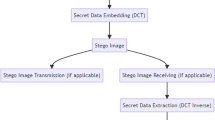Abstract
Plus minus 1 (PM1) is an improved method to least significant bits (LSB)-based steganography techniques, which not only foils typical attacks against LSB-based techniques, but also provides high capacity. But how to apply it to JPEG images does not appear in literatures. In this paper, PM1 steganography in JPEG images using genetic algorithm (GA) is proposed, in which the GA is used to optimize the performance, such as minimizing blockiness. Theoretical analysis to the histogram characteristics after steganography is discussed in details, which proves that PM1 used in JPEG images preserves the first-order statistical properties. Experiments show that the proposed method outperforms the other methods in terms of capacity and security.
Similar content being viewed by others
References
Chang CC, Chen TS, Chung LZ (2002) A steganographic method based upon JPEG and quantization table modification. Inf Sci 141: 123–138
Chu SC, Huang HC, Shi Y, Wu SY, Shieh CS (2008) Genetic watermarking for zerotree-based applications. Circuits Syst Signal Process 27 (in press)
Coley DA (1999) An introduction to genetic algorithms for scientists and engineers. World Scientific, Singapore
Fridrich J (2004) Feature-based steganalysis for JPEG images and its implications for future design of steganographic schemes. In: Proceedings sixth information hiding workshop’04, LNCS 3200, Springer, New York, pp 67–81
Fridrich J, Goljan M, Hogea D (2002a) Steganalysis of JPEG images: breaking the F5 algorithm. In: Proceedings fifth international workshop on information hiding’02, LNCS 2578, Springer, New York, pp 310–323
Fridrich J, Goljan M, Hogea D (2002b) Attacking the OutGuess. In: Proceedings ACM workshop on multimedia and security’02, France, pp 3–6
Fridrich J, Goljan M, Hogea D (2003) New methodology for breaking steganographic techniques for JPEGs. In: Proceedings SPIE, security and watermarking of multimedia contents V’03, vol 5020, pp~143–155
Goldberg DE (1989) Genetic algorithms in search, optimization and machine learning. Addison Wesley, Boston
Huang HC, Pan JS, Huang YH, Wang FH, Huang KC (2007) Progressive watermarking techniques using genetic algorithms. Circuits Syst Signal Process 26: 671–687
Li B, Huang FJ, Huang JW (2007) Steganalysis of LSB greedy embedding algorithm for JPEG images using coefficients symmetry. In: Proceedings fourteenth IEEE international conference on image processing’07, San Antonio, vol 1, pp 413–416
Michalewicz Z (1994) Genetic algorithms + data structures = evolution programs. In: AI Series. Springer, New York
Pan JS, Sung MT, Huang HC, Liao BY (2004) Robust VQ-based digital watermarking for the memoryless binary symmetric channel. In: IEICE Trans Fundam Electron Commun Comput Sci E-87A:1839–1841
Pan, JS, Huang, HC, Jain, LC, Fang, WC (eds) (2007) Intelligent multimedia data hiding: new directions. Springer, Berlin
Petitcolas FA, Anderson RJ, Kuhn MG (1999) Information hiding-a survey. In: Proceedings of the IEEE special issue on protection of multimedia content’99, vol 87, pp 1062–1078
Provos N (2001) Defending against statistical steganalysis. In: Proceedings tenth USENIX security symposium’01, Washington DC, pp~323–335
Sallee P (2003) Model based steganography. In: Proceedings international workshop on digital watermarking’03, LNCS 2939, Springer, New York, pp 154–167
Sallee P (2005) Model-based methods for steganography and steganalysis. Int J Image Graph 5: 167–189
Soukal D (2006) Advanced steganographic and steganalytic methods in the spatial domain. Diss Abstr Int 67-03(Sect B):1532–1704
Westfeld A (2001) F5—a steganographic algorithm (high capacity despite better steganalysis). In: Proceedings fourth international workshop on information hiding’01, LNCS 2137, Springer, New York, pp 289–302
Westfeld A, Pfitzmann A (2000) Attacks on steganographic systems. In: Proceedings third international workshop on information hiding’00, LNCS 1768, Springer, New York, pp 61–76
Zhang XP, Wang SZ (2005) Secure steganographic algorithm in JPEG images (In Chinese). J Electron Inf Technol 27: 1813–1817
Author information
Authors and Affiliations
Corresponding author
Rights and permissions
About this article
Cite this article
Yu, L., Zhao, Y., Ni, R. et al. PM1 steganography in JPEG images using genetic algorithm. Soft Comput 13, 393–400 (2009). https://doi.org/10.1007/s00500-008-0327-7
Published:
Issue Date:
DOI: https://doi.org/10.1007/s00500-008-0327-7




